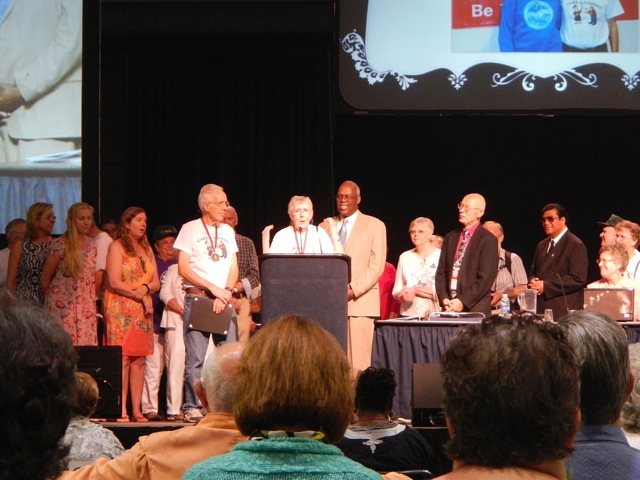 Annual Conference 2013 Day 2 journal
Annual Conference 2013 Day 2 journal
This is the second of four journal entries from the Annual Conference Session 2013 by Nick Strobel. Those interested in the results of the legislative resolutions can skip to the day 3 journal. Consider this a sort of personal journal of my thoughts and experiences at the ACS with a separate journal report for each day.
Eric Law opened the morning Holy Currencies session with a new version of the doxology that captures his Holy Currencies idea:
“Praise God from whom all blessings flow // Circling through earth so all may grow // Vanquishing fear so all may give // Widening grace so all may live // Alleluia…”
He had us identify five friends in our internal network (the church) and then identify what blessings were exchanged in the last encounter with our friends.
He had us identify five friends in our external network (outside the church) and then identify what blessings were exchanges in the last encounter with those friends.
Money is not the problem: we are only poor in our relationships.
In the 1950s the concern was how do we do church better than the other churches because it was rightly assumed that everyone would go to church. In the 21st century that assumption is no longer valid. Therefore, we need to build connections first. People, especially the younger people want to belong first and then they'll consider becoming members. Relationships are the cornerstone.
Law contrasted the goal-driven way of thinking with the relationship-driven way of thinking. Goal-driven is linear, talking, convincing, doing while with relationship-driven is circular/spiral, listening, trust-building, connecting. In the relationship-driven mode, he noted that the best way to respect someone is to ask for something in return (circular) so that they have the opportunity to give something back---you value their worth enough to want to get something from them and the giving is not just one way (top-down of worthy to unworthy)
One discussion point for our church is to select one of the goal-driven ministries and make them a relationship-driven ministry. For example, a landlord-renter relationship is goal-driven like the NA/AA group that rents room 1 at the church. Instead we could have church reps open up the room for them and attend a meeting or two or more. A soup kitchen line is goal-driven (assembly line with providers on one side of the counter putting food on the receivers' plates).
Bishop Brown introduced M.L. Carr, former NBA star and coach who is now chief operating officer of the Dream Company. The Dream Company has a relationship with the UMC and other denominations for providing insurance to churches and individual members.
We then went to Legislative Sections to work out the resolutions in the two hours before lunch. My section (section E) finished all of the ones assigned to us and all of them were put on the consent calendar (received at least 85% vote yea or nay; select the link to view a PDF of the consent calendar and amendments to any of the recommendation items) and we even took up another item that another legislative section (section A) didn't have time to get to because that section wrestled with the Tithing Proposal. Two people from the i-Relate team led us in two exercises that forced us to think before we spoke and to listen carefully. One was to describe how we got to the ACS today where every sentence had to use an additional verb that meant the same thing as the first verb. For example "I went-drove to the convention center". Another exercise was to quickly plan in 1.5 minutes a birthday party for Bishop Brown with each person in the pair starting their sentence with "yes BUT". Then we would plan the birthday party in 15 seconds with each person in the pair starting their sentence with "yes AND". Reflect on the differences between the two scenarios. Section E was assigned Item 9 Preserve the Rain Forest, Item 17 Engagement with the Western Jurisdiction, Item 19 Opposition to the Keystone Pipeline, Item 22 Freedom of Expression on California Academic Campuses, and Item 23 Location of the Annual Conference Session 2017. See the amendment sheet (page 2 of the PDF) for how these items were perfected in the legislative section.
Two Bishop's Award winners were couples that are heavily involved in UMVIM in other parts of the country or world and also mission projects in their local community: Rod and Gloria Castor (above) and Ken and Paula Blackshear (at right) |
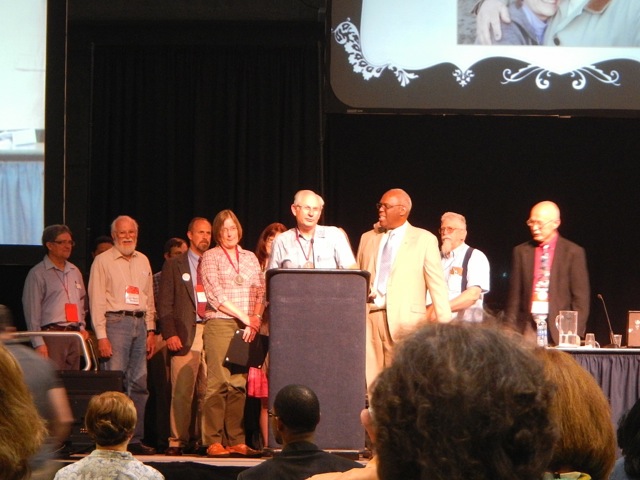 |
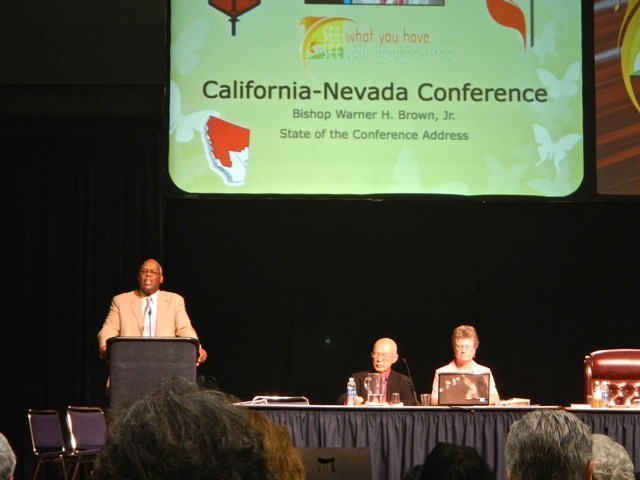
Bishop Warner Brown gives the State of the Conference Address
In building bridges with those we oppose, Bishop Brown noted a famous Wesley saying: "Give me your hand so that we can find a third way". In our past conflicts within the church we have wielded our power without regard to how we could find a way for love. We need to not get stuck at what we fear. The Annual Conference is definitely filled with passionate people who passionately hold to their beliefs but if we peek from behind the barricades of our biases, we will miss seeing our neighbors as they really are and we will see only the caricatures we want them to be.
Bishop Brown reminded us of the Annual Conference-wide strategy for revival, renewal, and reach. Our number one priority is calling forth, encouraging, equipping and positioning servant leaders (clergy and lay) to join with the movement of God's mission in the world. Our spiritual directions are those from Catch Fire in 50 Days.- All congregations in our Conference have a clear, simple vision and strategy for making disciples in their unique context who reach their mission fields;
- Our Conference culture naturally encourages innovative ways of multiplying disciple-making movements to create new places for new people;
- One-third of the congregations in the Conference are starting something new that reaches new people through context-discerned models of new faith communities, and/or new expressions of current offerings;
- We have a new multicultural congregation that consistently engages no fewer than 1,000 active participants each week;
- We have at least five existing congregations with no fewer than 1,000 active participants each week;
- We have at least 20 faith communities with no fewer than 500 active participants each week.
He gave an example of San Jose First UMC work in downtown and the combining of the Good Shepherd UMC and El Cerrito UMC into Open Door UMC---see the short video above. Among other things, they are connecting those who have resources such as furniture stores/suppliers with those who don't have (the working poor). We saw slides of Vida Nueva in Porterville and Church of the Joyful Healer.

The "Journey of the Saints" worship service was in the late afternoon before dinner. This is a memorial service paying tribute to pastors, pastor spouses, and laity who have died in the past year. One of the remembered clergy was Bob Sanford who was a pastor of Wesley UMC from 1973 to 1978. I brought home the memorial book—see page 14 for Bob Sanford's memorial. The worship service also recognizes retiring clergy and ones who will be ordained at this annual conference. In the picture above, the pictures of the saints who have passed on to greater glory are on the white table at right. I like the song used for the opening of the Journey of the Saints: "Hallelujah (Your Love is Amazing)" by Brown and Doerksen which is #3027 in the new hymnal Worship and Song. In the picture below, a representative of the retired clergy lights the candle held by one of the clergy who will be ordained at this Annual Conference.
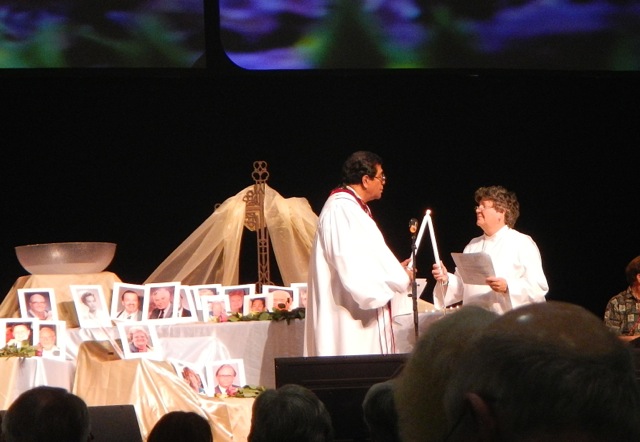
After dinner, we had a session with Rev. George "Tink" Tinker from Iliff about the history of the European Christian invasion and displacement of the Native American people and some thoughts of where we go from here given this very violent behavior in our past, even recent past. [He helped lead an "Act of Repentance Toward Healing" at the General Conference 2012. See the GC2012: Starting along the past of repentance link for more on that.] Tink Tinker clearly laid out the desperate conditions on today's reservations. He contrasted the European hierarchical individualistic culture with the harmony + balance culture of Native Americans where they are in relationship with each other and with all of God's creation. These two cultures have opposing worldviews. He did note that the one "God" (or "Great Spirit") is a monotheistic European missionary invention that continues the up-down hierarchy.
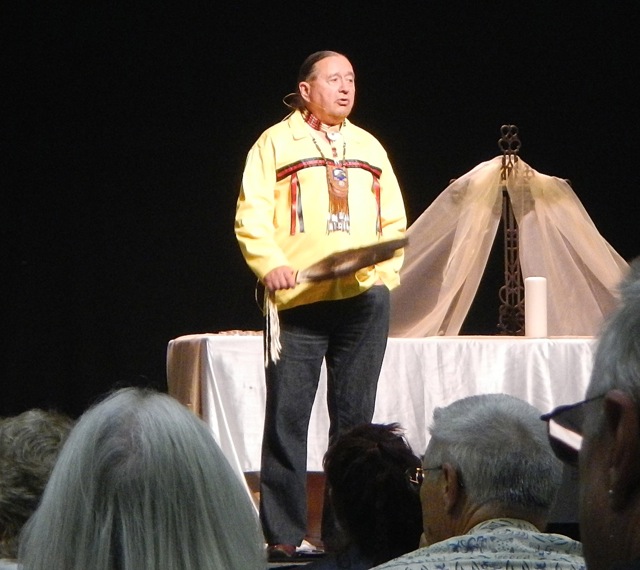
We Eurocentric culture people need to figure out how to change our way of thinking to return to harmony and balance. Native Americans cannot help us with that. It is our problem!
Books mentioned in the Q/A with Rev. Tinker: "Race, Gender, and Class" textbook by Bart Landry (Karen has it in her office from her seminary days) and "Iroquoian Women: The Gantowisas" by Barbara Alice Mann.
